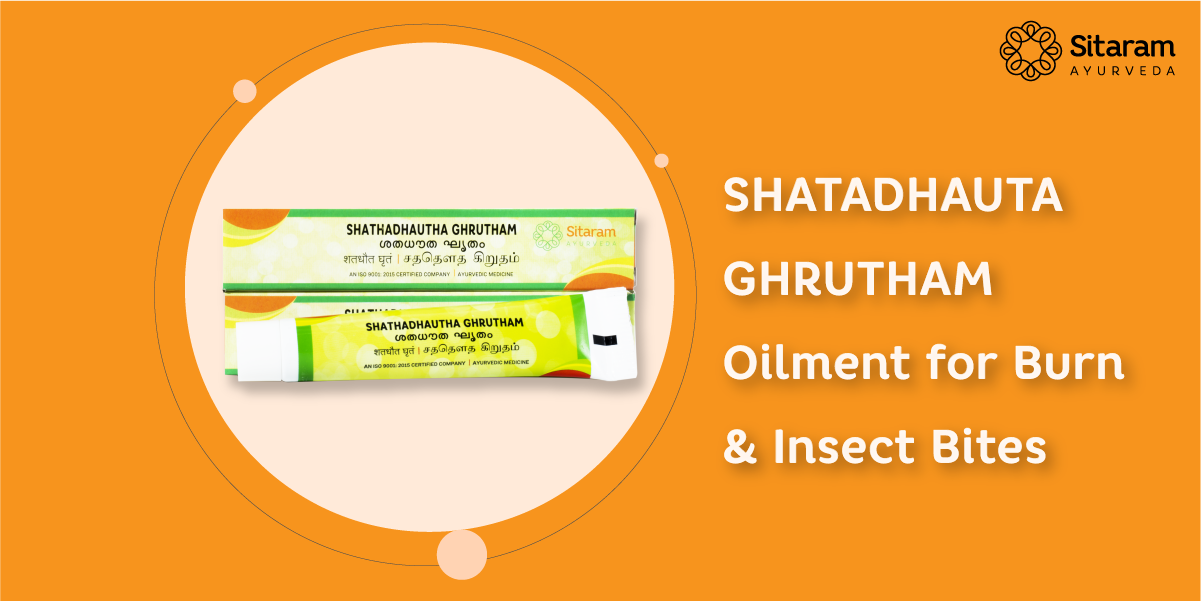SHATADHAUTA GHRTA – Oilment for Burn & Insect Bites

Sitaram’s Shathadhautha Ghritham is formulated with repeatedly washed butter as its base, making the anointment highly cool in its potency serving great relief to the areas of skin suffering from burns, inflammatory acne, insect bites etc. The astringent medication is best for inflammations, as well as for burning sensations on the skin and around the anal region. It nurtures the irritant skin, revives the dull and imparts highly cosmetic and therapeutic effect accounting to its nourishing property. This soothing nature is because of the Nalpamara Kashaya which is an ingredient of its formulation.
Key features:
- Ayurvedic medicine with profound cooling action.
- Herbal remedy to ease burns and blisters.
- A natural solution to assuage insect stings.
- Ayurvedic help to dull dry and chapped skin.
- Verdant relief for acne marks and facial scars.
Have you been suffering from a burn scar that is stubborn enough to not fade?
Are you struggling to get relief from that stinging insect bite?
Or are you suffocated by those red inflammatory acne bumps on your skin?
Shatha Dhautha Ghritam can help mitigate these symptoms and will bring relief to your suffering.
Sitaram Shatha Dhautha Ghritam
With amazing herbal coalescence having active healing potential and anti-inflammatory properties, Sitaram’s Shathadhautha Ghritham is the glorious whisk for all scars, burns, and inflammations over the skin’s surface.
Special features:
- Soothes the pain and skin irritation.
- Astringent in nature, balancing skin doshas.
- Helps to rebuild dermal tissue.
- Boosts the healing process.
- Removes scars, spots and dark circles.
This is the simplest dose of essential Ayurveda for your skin. Be it a home remedy you are searching for bug bites that itch and cause swelling or a solution for dark acne spots, Sitaram’s Shatha Dhautha Ghritham is the most economical, natural, and potential product you can rely on.! It is made from the best natural herbs with their active compounds having a healing, immuno-regulatory, anti-microbial and anti-inflammatory properties.
Kernel of Herbs:
- Ficus benghalensis (banyan fig):
Extracts of banyan tree both ethanolic and aqueous, have properties like elevated wound healing. They regenerate the epithelial layers of skin through inflammatory control and collagen release in the deep layers of the skin including the dermis. This helps in the remodeling of the affected area, be it the scar or sound. Ficus benghalensis accelerates the healing process. In addition, they have Antioxidant, Anti-allergic and immunomodulatory actions. Hence, they are traditionally administered for wounds, ulcers, inflammatory conditions and swollen joints.
- Ficus religiosa (sacred fig):
One among the Panchavalkala (five bark drugs) in the Indian system of medicine. Its powdered bark has been extensively used in inflammatory conditions and swellings to ease them down. This aerial-rooted glabrous tree is known to have disinfectant, laxative, and antiseptic effects. Its bark got appreciable amounts of beta-sitosterol, stigmasterol, Vitamin K, and lanosterol, hence the bark powder is used in the treatment of unhealthy ulcers and wounds. Alongside the similar plants of the same species, it is combined to obtain the intermix serving highly potential healing effects.
- Ficus racemosa (cluster fig):
This evergreen lactiferous tree is a popular medicinal herb in India, widely in use for inflammatory conditions, urinary disorders, hemorrhoids, etc. It is locally called ‘Gular’ and every part of the plant is medicinally improved. The bark of cluster fig contains large amounts of polyphenolic compounds and is extensively used in the indigenous system of medicine for its Antioxidant, Antipyretic, and Anti-inflammatory actions. It helps with reducing the pain or irritation and heals the affected tissues fast.
- Ficus microcarpa (curtain fig):
The magnificent herb with both medicinal and non-medical importance. Besides its spiritual significance, Focus macrocarpa and its aerial roots are rich storehouses of numerous Phenolic acids, flavonoids, Triterpenoids, etc. They are known to have Anti-carcinogenic, Anti-inflammatory, and Anti-bacterial actions and have been used in folk medicine and ancient medical practices for a long time.
- Rubia cordifolia (common madder)
Rubia cordifolia is popular for its wound contractor functions and activity in healing burn scars. The drug, when administered to the affected area of skin, inflicts a good percentage of epithelialization and decreases the toxic inflammatory changes. Their Anti-microbial and Anti-inflammatory actions accelerate the wound healing and stages of skin remodeling in the case of scar treatment processes.
- Beeswax
Dating back to Egyptian practices, Beeswax has been used as a remedy to Burma’s wounds and other painful conditions of the skin. It is rich in Vitamin A and is highly hydrophobic. The same reason it will keep your skin from getting excessively dry and chapped. It speeds up the healing process and keeps the infections at bay accounting for its antimicrobial character.
- Ghee
As documented over centuries in Ayurvedic classics and Vedic literature, Ghee is important for its topical and systemic qualities. Ghee helps with the reduced release of leukotrienes and prostaglandins and maintains the inflammatory levels in check. As per the classics and ancient practices it is found to be effective in overcoming a burn, insect bite, and is extremely beneficial in tissue repairing and wound healing.
How to use:
Pat dry the area of the skin affected after cleaning and apply small dabs of Sitaram’s Shathadhautha Ghritham over the sting/burn/scar/inflammation. Apply in circular motions till it is completely absorbed into the skin and leave till it’s dry.
Safety remarks:
Only for external Applications and keep out of reach of children.
This is the magic spell for your skin rebuilding procedure. So, wait no more.!


 Sign In
Sign In Cart
Cart